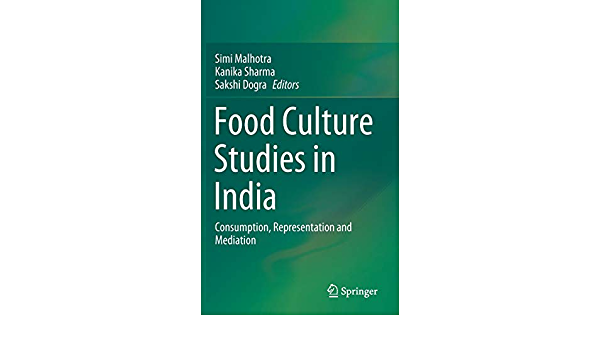
Food is a powerful tool for the analysis of identities, societies and cultures. Food may uphold the status quo by reinforcing oppressive social, political and cultural norms, but it may also challenge and subvert intersecting power structures. In recent years, the academic field of food studies has grown exponentially, with rich scholarship emerging from the Global South. I believe that food contains diverse possibilities which allow for innovative and interdisciplinary research. This edited volume by Simi Malhotra, Sakshi Dogra and Kanika Sharma Food Culture Studies in India: Consumption, Representation and Mediation, published by Springer in 2021attempts to draw upon interdisciplinary methods and approaches to think through the complex connections between food, society and culture. The volume offers its readers a mélange of articles which span the humanities and social sciences.
The volume uses food as a discursive medium to bring to the forefront the heterogeneity of Indian culture. It offers a range of articles which discuss various food practices, eating cultures, food rituals, culinary traditions, stories and folklore, visual media as well as the impact of colonialism. The volume is divided into four sections – Food Fads, Narrating Nourriture, Visual Victuals and Of the Colonial and the Culinary – all of which complement one another. Interestingly, the collection contains cultural representations of India as well as from the west. Moreover, while certain essays explicitly focus on the central theme of food and Indian culture, other essays make use of food to showcase a global consumer culture.
The first part of the volume deals with the ever-expanding culture of food fads, diets, fitness and the wellness industry. I was particularly intrigued by the first essay which discusses consumerism, consumption and the global market. The article presents a sharp criticism of how the ideas of fitness and good health had led to a growth in the consumption of certain health-related food and supplements. Often enough, health supplements are not central to traditional food studies, but this article makes a compelling case for their inclusion. It also provides a nuanced analysis of the ramification of targeted advertisements on Indian consumer culture.
The second part of the volume turns away from the sciences toward humanities with a range of articles on literature, culture and food. The two essays which stood out for me were ‘Who Eats Whom?: Transcending the Real Purpose Behind Food Events in Children’s Literature (If Any!) Through Nonsense Literature’ by Arunima Chanda and ‘Food, Love and the Self in Indian Women’s Poetry in English’ by Shruti Sareen. Chanda’s essay supplies a detailed overview of how metaphors of food allow for imagined and imaginary worlds. Food performs a subversive act of collapsing structural hierarchies and challenges cultural norms. Sareen’s essay also focuses on the dissident possibilities of food, tastes and female appetites. She utilizes food to assert the importance of identity and selfhood in the works of contemporary poets, such as Sumana Roy and Tishani Doshi.
The third section playfully weaves together food and visual culture through films, advertisements, TV shows and animation. The article that was most appealing to me was the one on the Godfather Trilogy by Arup Chatterjee. Chatterjee makes use of food-related fantasy and myths to take the film series in a new and innovative direction. I also enjoyed reading the detailed representation of chocolate in the article, ‘Chocolate and the Holly Factory: Analysing the “Role” of Chocolate in Select Films from Hollywood’ by Deepti Razdan and Jyoti Arora. Undoubtedly, western films have had an immeasurable influence on urban, middle-class Indian audiences. However, I was a little disappointed to not find a single essay on Indian films and TV shows.
The final segment of this volume grapples with the legacies of colonialism as well as acts of cultural resistance. This section includes many fascinating articles on resistance, movements and cultural memory. I found ‘Of Khaar, Pithaa and Aitaa’r Posola: Exploring the Folk Aesthetics and the Erotic in Assamese Food’ by Rini Barman and Prerana Choudhury to be incredibly interesting. I also enjoyed ‘Hunger Games: Politics of the Ema Market, the Kitchen and Protest in Manipur’ by Samurailatpam Tarun Sharma and Sumitra Thoidingjam. While the former article uses food to discuss the importance of traditional rituals and folklore, the latter reinscribes women’s food work as resistance.
The edited volume collapses the binaries between the local and the global to bring together a collection of varied articles on food and culture. The volume presents a fairly comprehensive overview of current scholarship on food and culture in India. I would have liked to see more essays on regional literature, films, TV and other popular media. However, the editors have commendably brought together varied and multifaceted notions of food in this edited volume.
***
Sohni Chakrabarti holds a PhD in English Literature from the University of St Andrews. She also has an MA in Modern and Contemporary English Literature from the University of Bristol and a BA in Psychology from the University of Pune, India. Her research critically examines the complex ways in which nostalgia influences the imagination of identity, home and belonging in contemporary American diasporic women’s writing. Her work explores the intersections of gender, race, class and culture in the works of women’s writers across diasporas in order to actively place them within the feminist literary canon. She is currently researching on a post-doctoral project on food, masculinity and memory in contemporary American cultures.